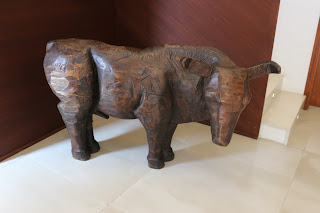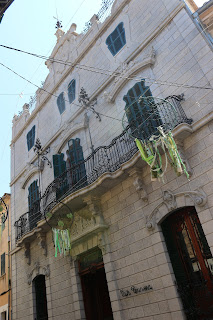Can Prunera Museu Modernista is located in an old art nouveau mansion built in the early 20th century. A combination of sinuous, natural and animal-like shapes welcome visitors to a museum which has become one of the features of the town of Sóller. Can Prunera, together with other buildings in Palma such as the Grand Hotel, Can Forteza Rey and Can Casasayas, belongs to a large set of buildings erected in Mallorca in the early 20th century following the models of Catalan Modernisme and French Art-nouveau.
Can Prunera was restored through the joint efforts of the
Sóller Railway company and the Serra Art Foundation who formed the Tren de
l'Art Foundation to foster the cultural and artistic development of the Sóller
valley. Two exhibition halls, Joan Miró and Pablo Picasso, were created at
Sóller railway station plus a Sculpture Park at the end of the tramway line
that links Sóller and Port de Sóller. In Palma, at the Sóller Railway Station,
there is also a hall showing “50 Landscapes of Majorca”. After almost three
years of restoration and refurbishing, Can Prunera Museu Modernista was opened in
August 2009. Since its creation, the Foundation has organized a large number of
exhibitions, which have turned Sóller into an important meeting point for artistic
creation.
The ground and main floor rooms contain some of the original
furniture along with paintings and sculptures from the Collection. On the
second floor, is the exhibition Del Modernisme al segle XXI [From art
nouveau to the 21st century], a set of paintings belonging mainly to the
Serra Art Collection. The collection’s masterpieces encompass works by
important artists from the 19th and 20th centuries, such as Miró, Henri de
Toulouse-Lautrec, Paul Klee, Fernand Léger and Maurice Vlaminck. Alongside, are
painters who were either born in Mallorca or have some link to the island and
have reached international recognition, such as Rusiñol, Mir, Joan Fuster,
Eliseu Meifrén, Ritch Miller and Miquel Barceló. The collection has been
enlarged over the past few years with works donated by private owners and
artists to the Tren de l’Art Foundation. On my visit I saw works by Helen
Frankenthaler, Albert Gleizes, Rebecca Horn, Hermann Nitsch, Jaume Plensa,
Diego Rivera, and Antoni Tàpies, among others.
In the basement, there are the rooms popularly known as
botigues – the domestic service spaces and stores - which nowadays host
temporary exhibitions and rooms devoted to Juli Ramis, a pioneer of materic
abstract painting in Spain. In the 1960s Ramis achieved international
recognition, with Time magazine including him in a list of the best one
hundred painters in the world. He was friends and shared his atelier with
Wilfredo Lam, Jean Fautrier, Serge Poliakoff and Nicolas de Staël. He also had
friendships with Picasso, Juan Gris and Miró. As a result, he is the most
internationally recognised Majorcan painter of the first half of the 20th
century. The collection includes canvases from three of the most representative
periods in his oeuvre: early years, Cubism and abstract works. Finally, in the
garden, visitors can contemplate the Foundation’s collection of sculptures.
The current temporary exhibition Salva Ginard 20/20 presents 20 paintings from a 20-year project of painting human faces “as a secret, intimate and personal language, a partially veiled confession,” that lives in the “landscape of experiences” which “regrouped and forced to live together,” shape each face “in a sort of hallucinated and revealing cryptogram.” Across that 20-year period, Ginard moved from “absolute darkness”, scratching the surface until he could see “dull colours that drew out the map of a wounded heart” to vivid, pure, even brilliant colours sliding along the fringes combined with “partial or wholescale elimination of the image to take advantage of its echo to begin again.” In between, are figures that have been “deconstructed into layers, pieces or blotches of colour, even until their disappearance” - scratched, uprooted violently, in order to delve “deeper into the idea of destruction / reset, wounding / curing.”
-----------------------------------------------------------------------------------------------------------
Peter Sheppard Skaerved - Telemann B-Minor Fantasie.





















No comments:
Post a Comment